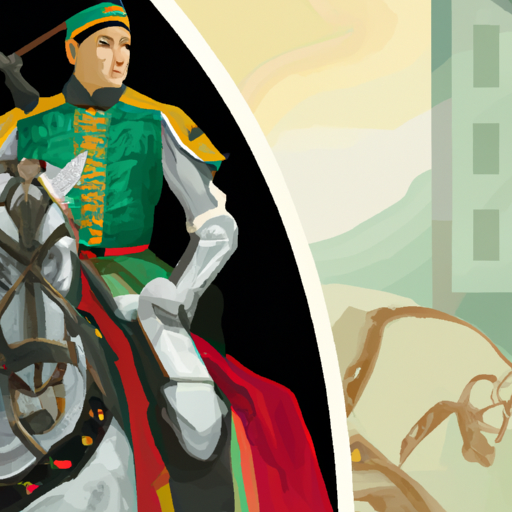Exploring the Ancient History of Mesopotamia: What Came Before?
Delve into the depths of antiquity and uncover the secrets of what lies beneath! Unearth the past and discover the wonders that once existed in Mesopotamia! Uncover a world of mystery, intrigue, and ancient civilizations! Discover what was before and marvel at the grandeur of times long gone.

A realm of mystique and intrigue, Mesopotamia has been captivating historians for centuries. From the earliest known civilizations in the region to the rise and fall of empires, it is an ever-evolving field of study that can provide insight into our own modern societies.
Agriculture and trade were two cornerstones of Mesopotamian culture, with cities such as Babylon, Nineveh, Ur, and Uruk playing a vital role in its development. Ancient artifacts found within these cities include cuneiform tablets containing literary works such as the Epic of Gilgamesh as well as cylinder seals used for administrative purposes. Religion was also prominent in this region, with polytheism, animism, and astrology all practiced by its inhabitants.
Even now, archaeologists are uncovering new information about life in Mesopotamia through their work on ancient cities and monuments. What they discover can help us gain a better understanding of this civilization’s influence on our modern world – from politics to art and religion – and further explore its mysteries and wonders!
.
Introduction

A perplexing and tumultuous past lies hidden beneath the sands of Mesopotamia. Evidence suggests that as far back as 10,000 BCE, hunter-gatherer societies had already settled in the area. These were followed by Neolithic cultures that are believed to have emerged around 7000 BCE. Uruk is thought to be the first true city-state in the region, emerging around 3500 BCE. This was then succeeded by other civilizations such as Sumer and Akkad, which prospered until 1750 BCE when Babylon conquered it.
– Ancient History of the Fertile Crescent Before Mesopotamia
A region of the Middle East, from Turkey in the north to Egypt in the south, has seen many transformations throughout its long history. From 8500 BCE, this area was home to nomadic hunter-gatherers who moved seasonally between different areas based on resources available at any given time. Over time, these societies developed into more complex cultures that began to settle down and cultivate their own crops and domesticate animals. Around 3000 BCE, much of the Fertile Crescent was united under one powerful ruler: Sargon of Akkad. His reign marked a period of great prosperity for many areas within his domain as he encouraged trade and commerce throughout his kingdom.
The Sumerians then migrated into lower Mesopotamia from northern regions such as Elam and Assyria around 2300 BCE. They established their own city-states which eventually coalesced into ancient Mesopotamia – arguably one of the most influential civilizations in world history. Sumerian culture spread throughout much of what is now Iraq and parts of Iran as well as other regions further east such as Pakistan and India.
The Fertile Crescent has been subject to numerous foreign invasions over the centuries, including those led by Alexander the Great’s Macedonians and Genghis Khan’s Mongol hordes. Despite these disruptions, this region still retains its cultural heritage today – providing us with an invaluable insight into our collective pasts.
– Prehistoric Civilizations in the Middle East Before Mesopotamia
Awe-inspiring and remarkable, the Middle East has been home to some of the oldest civilizations in human history. Preceding the ascension of Mesopotamia, a number of powerful and influential prehistoric societies flourished in the region. These ancient cultures were responsible for laying down foundations for many aspects of modern life today—from engineering feats to writing systems—ultimately helping pave the way for later civilizations like Mesopotamia. Here, we will explore some of these notable prehistoric cultures that shaped the Middle East before Mesopotamia.
Ubaid culture was one early civilization that existed in southern Iraq between 5500 and 4000 BCE. This society was credited with creating some of earliest examples of large-scale irrigation systems and public buildings, as well as developing a complex system of trading networks that spanned much of the region. Ubaid people also left behind impressive artworks such as painted pottery and stone sculptures.
Uruk was another important civilization that existed from 4500 to 3100 BCE in modern-day Iraq. This society is said to have invented writing and developed an advanced form of urban planning known as “the grid plan”—which featured streets arranged in a neat grid pattern around a central temple or palace complex. Uruk also had remarkable architectural feats, including stepped pyramids called ziggurats.
Sumerian civilization is another significant precursor to Mesopotamian culture—arising around 3000 BCE in southern Iraq and lasting until 1800 BCE when it fell under Babylonian control. Sumerians are credited with developing sophisticated mathematics, astronomy, literature, other sciences; as well as introducing cuneiform writing—a system that used wedge-shaped symbols on clay tablets to record information about trade transactions and religious rituals.
Finally, Elamite culture flourished from 3000 to 550 BCE in what is now southwestern Iran. This society created its own unique language and script; made great strides in architecture; crafted intricate metal works; and established extensive trading networks with neighboring cultures like Sumerians and Assyrians.
These are just a few examples of prehistoric civilizations that had an indelible impact on history before Mesopotamia rose to power in the Middle East region.
– Exploring the Ancient History of Sumerian Culture Before Mesopotamia
Mystery and wonder surround the Sumerian culture, one of the oldest known civilizations in human history. Believed to have originated around 4000 BCE, the culture is often referred to as the cradle of civilization. Its influence was vast and far-reaching, with its center located in what is now modern-day Iraq and Kuwait. Investigating this ancient society can provide us with a unique perspective on how it developed and impacted other cultures.
The Sumerians were a polytheistic people who believed in multiple gods and goddesses, worshipping them in elaborate temples. Religion played an important role in their daily lives, providing guidance on how to live and interact with others. They also had a complex writing system called cuneiform that allowed them to document their thoughts, beliefs, and laws.
The Sumerians were an advanced society that developed many technological innovations such as irrigation systems for farming, wheeled vehicles for transportation, bronze weapons for warfare, and pottery for storing food. This enabled them to become one of the most powerful societies of their time.
Their culture was rich with literature, music, art, architecture, mathematics, astronomy, and law codes; much of which was adopted by later civilizations such as Babylonians and Assyrians after they occupied parts of Mesopotamia following its fall under Sumerian control.
Exploring the ancient history of Sumerian culture before Mesopotamia can give us insight into our own pasts while appreciating its importance in shaping our present day world. By understanding this history we can gain valuable knowledge about how this early society evolved over time and what impact it had on other cultures in the region.
– The Rise and Fall of Ancient Empires in the Region Before Mesopotamia
The ancient world is full of stories of empires that flourished and then faded away in the time before Mesopotamia. From the Akkadian Empire to the Hittite Empire, many civilizations have left a lasting impression in this region.
The Akkadians were one of the first known empires in the area, starting around 2300 BC. They were known for their advanced military technology and their engineering feats, including irrigation systems and fortifications. Additionally, they created a writing system called cuneiform which allowed them to record laws, literature, and other documents. Unfortunately, internal strife and foreign invasions eventually led to its demise in 2154 BC.
The Hittites were another prominent empire before Mesopotamia. They began around 2000 BC in Anatolia (modern-day Turkey) and quickly rose to power as a major force in the Middle East. Their capital city Hattusa was an important center for trade and culture; many monuments still standing today are reminders of their greatness. The Hittites had a powerful military which enabled them to conquer much of modern-day Syria, Lebanon, Israel, Jordan, and parts of Egypt during their peak period from 1650 – 1200 BC. But due to pressure from Assyrians and Babylonians they declined around 1180 BC.
Other notable empires that existed before Mesopotamia included the Elamites who controlled western Iran from 3000 – 640 BC; The Kassites who ruled Babylonia from 1595 – 1155 BC; And the Mitanni who dominated northern Syria from 1500 – 1360 BC among others. These powerful empires have left behind a legacy that has helped shape our understanding of history today.
– Examining Early Trade Routes and Cultural Exchange Before Mesopotamia
A perplexing and intricate narrative is revealed when exploring the history of early trading routes and cultural exchanges prior to Mesopotamia. Before modern transportation, humanity relied on local resources for sustenance; yet as populations grew, so did the demand for goods from other lands. This led to the formation of extensive trading networks that allowed for products to be exchanged between different regions, alongside a cultural exchange between those involved in the trade.
The earliest evidence of such long-distance trading dates back to 6500 BC in Anatolia (modern-day Turkey), where obsidian was being traded from there to other parts of Europe and Asia – suggesting this type of commerce had already been established at an early stage in human history.
Networks continued to develop throughout the Neolithic period, with a well-established one connecting Mesopotamia with Egypt and other Middle Eastern areas by 3000 BC. This network enabled commodities like grain, cloth, metal tools and pottery to be exchanged among various cultures in these regions, as well as ideas and beliefs shared through it.
In addition to these large-scale trading systems, smaller regional networks emerged over time too – linking communities within one region or country and allowing them access to resources not available locally. These regional networks also contributed significantly towards overall wellbeing.
Examining early trade routes and cultural exchanges before Mesopotamia provides us with valuable insight into how our ancestors interacted with each other during ancient times; by understanding how these trading networks operated we can gain a better appreciation of how they managed to survive despite limited resources – through cooperation and innovation.
conclusion

For millennia, the region now known as Mesopotamia has been a site of mystery and intrigue. Little is known of the cultures that inhabited the area prior to the fourth millennium BCE, though speculation abounds that hunter-gatherers may have roamed the area. Could they have interacted with one another? Could they have exchanged goods? Though no concrete proof exists, these questions remain unanswered. However, it is certain that from this period onwards, a variety of different civilizations and cultures have left their mark on this ancient land.
.
Some questions with answers
Q1. What is the history of Mesopotamia?
A1. Mesopotamia is an ancient region located in the Fertile Crescent of modern-day Iraq, Kuwait, Syria, and Turkey. It was one of the earliest civilizations in human history and dates back to around 4500 BCE.
Q2. What was before Mesopotamia?
A2. Before Mesopotamia, there were several other civilizations that existed in the area such as Sumerian city-states and Akkadian Empire. These civilizations date back to around 3500 BCE and are considered to be some of the oldest known civilizations in human history.
Q3. Who were the first people to inhabit Mesopotamia?
A3. The first people to inhabit Mesopotamia were Sumerians who settled in the area around 4000 BCE. They developed a complex culture with their own language, writing system, architecture, and religion which laid the foundations for many subsequent civilizations in the region including Babylonian, Assyrian and Persian Empires.
Q4. How did civilization develop in Mesopotamia?
A4. Civilization developed rapidly in Mesopotamia due to its favorable climate and geography which allowed for abundant food production and enabled trade between different regions of the world. This led to population growth, urbanization, technological advancements such as writing systems and irrigation systems, and cultural developments such as literature and art forms which have had a lasting impact on human history till this day.
Q5. What legacy did Mesopotamian civilization leave behind?
A5. The legacy of Mesopotamian civilization is still visible today through its contributions to science, technology, literature, art forms, religion, law codes and government structures which have all shaped modern society in some way or another over time. Additionally, many aspects of Sumerian language have been preserved throughout history making it one of earliest known languages still spoken today by some communities in Iraq and Iran





